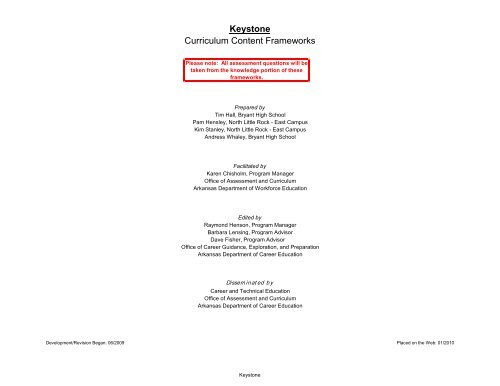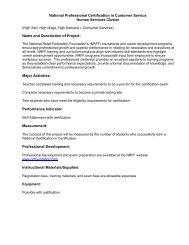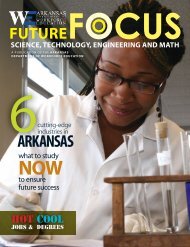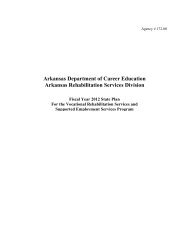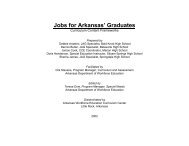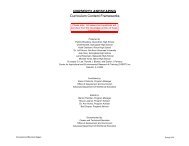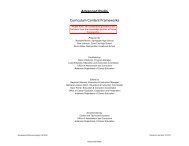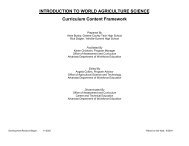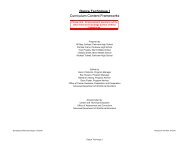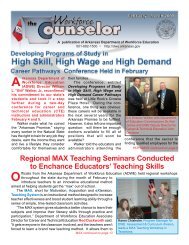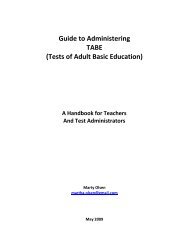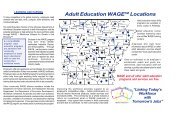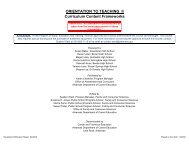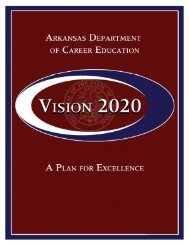Keystone Frameworks - Arkansas Department of Career Education
Keystone Frameworks - Arkansas Department of Career Education
Keystone Frameworks - Arkansas Department of Career Education
You also want an ePaper? Increase the reach of your titles
YUMPU automatically turns print PDFs into web optimized ePapers that Google loves.
<strong>Keystone</strong><br />
Curriculum Content <strong>Frameworks</strong><br />
Please note: All assessment questions will be<br />
taken from the knowledge portion <strong>of</strong> these<br />
frameworks.<br />
Prepared by<br />
Tim Hall, Bryant High School<br />
Pam Hensley, North Little Rock - East Campus<br />
Kim Stanley, North Little Rock - East Campus<br />
Andress Whaley, Bryant High School<br />
Facilitated by<br />
Karen Chisholm, Program Manager<br />
Office <strong>of</strong> Assessment and Curriculum<br />
<strong>Arkansas</strong> <strong>Department</strong> <strong>of</strong> Workforce <strong>Education</strong><br />
Edited by<br />
Raymond Henson, Program Manager<br />
Barbara Lensing, Program Advisor<br />
Dave Fisher, Program Advisor<br />
Office <strong>of</strong> <strong>Career</strong> Guidance, Exploration, and Preparation<br />
<strong>Arkansas</strong> <strong>Department</strong> <strong>of</strong> <strong>Career</strong> <strong>Education</strong><br />
Dissem in at ed b y<br />
<strong>Career</strong> and Technical <strong>Education</strong><br />
Office <strong>of</strong> Assessment and Curriculum<br />
<strong>Arkansas</strong> <strong>Department</strong> <strong>of</strong> <strong>Career</strong> <strong>Education</strong><br />
Development/Revision Began: 06/2009<br />
Placed on the Web: 01/2010<br />
<strong>Keystone</strong>
Curriculum Content <strong>Frameworks</strong><br />
<strong>Keystone</strong><br />
Grade Levels: 9 - 10<br />
Prerequisite: None<br />
Course Code: 493850<br />
Course Description: The <strong>Keystone</strong> course is designed to help ninth graders successfully navigate high school. Students will receive instruction on study skills, time<br />
management, and goal setting strategies. Students will receive guidance in investigating their own interests and aptitudes in relation to possible careers and will<br />
begin developing a flexible education plan for both high school and post secondary studies or technical training. This transition course will create a sense <strong>of</strong><br />
belonging among students by having them become productive citizens <strong>of</strong> their school and the community.<br />
Table <strong>of</strong> Contents<br />
Unit 1: Keys to Personal and Academic Success<br />
1<br />
Unit 2: Life Skills<br />
4<br />
Unit 3: Financial Management 7<br />
Unit 4: <strong>Career</strong> Planning and Employability Skills 8<br />
Glossary<br />
10<br />
<strong>Keystone</strong>
Unit 1: Keys to Personal and Academic Success<br />
Hours: 16<br />
Terminology: Accountability, Agenda, <strong>Career</strong>, College credit, College hour, Date planner, Extracurricular, Goals, Grade Point Average (GPA), Hand held device, Learning styles, Maturity,<br />
Paradigm, Technical institutes, Time management, Transcripts, Transition<br />
CAREER and TECHNICAL SKILLS<br />
What the Student Should be Able to Do<br />
ACADEMIC and WORKPLACE SKILLS<br />
What the Instruction Should Reinforce<br />
Knowledge Application Skill Group Skill Description<br />
1.1 Define terms related to the 1.1.1<br />
<strong>Keystone</strong> program, personal<br />
and academic success<br />
Apply terminology correctly and<br />
appropriately<br />
Foundation<br />
Reading<br />
Listening<br />
Applies and understands technical words that<br />
pertain to <strong>Keystone</strong> [1.3.6]<br />
Comprehends ideas and concepts related to<br />
<strong>Keystone</strong> Program [1.2.1]<br />
Writing Uses words appropriately [1.6.21]<br />
Speaking<br />
1.2 Summarize the importance <strong>of</strong> 1.2.1 Design a personal plan that correlates Thinking Creative Thinking<br />
school policies<br />
school goals to personal goals<br />
Applies/uses technical terms as appropriate to<br />
audience [1.5.2]<br />
Creates new design by applying specified criteria<br />
[4.1.3]<br />
Personal<br />
Management Skills<br />
Responsibility<br />
Is punctual to class, school meetings, and<br />
activities [3.4.6]<br />
1.2.2 Evaluate personal goals in relation to<br />
Decision Making<br />
community/society needs<br />
1.3 Name resources for local school 1.3.1 Determine appropriate resources for Personal<br />
Organizational<br />
specific needs: administrators,<br />
Management Skills Effectiveness<br />
counselors, nurse, librarian<br />
Thinking<br />
Knowing How To<br />
Learn<br />
1.4 Describe the benefits <strong>of</strong> 1.4.1 Investigate available extracurricular Foundation Speaking<br />
participation in extracurricular<br />
activities<br />
activities and CTSO<br />
Evaluates information/data to make best decision<br />
[4.2.5]<br />
Comprehends the organization's modes <strong>of</strong><br />
operation [ 3.3.5]<br />
Processes new information as related to school<br />
resources [ 4.3.5]<br />
Organizes ideas and communicates oral<br />
information to listeners regarding extracurricular<br />
activities [1.5.7]<br />
Thinking<br />
Knowing How To<br />
Learn<br />
Processes new information as related to<br />
extracurricular activities [4.3.5]<br />
<strong>Keystone</strong><br />
1
CAREER and TECHNICAL SKILLS<br />
What the Student Should be Able to Do<br />
ACADEMIC and WORKPLACE SKILLS<br />
What the Instruction Should Reinforce<br />
Knowledge Application Skill Group Skill Description<br />
1.4.2 Determine which extracurricular activity is Thinking Decision Making<br />
most appropriate<br />
1.4.3<br />
Identify the <strong>Career</strong> Technical Student<br />
Organization within your school in relation<br />
to <strong>Keystone</strong><br />
Personal<br />
Management Skills<br />
Problem Solving<br />
<strong>Career</strong> Awareness,<br />
Development, and<br />
Mobility<br />
1.5 Discuss the concepts <strong>of</strong> change 1.5.1 Identify personal change and transitional Interpersonal Skills Teamwork<br />
and transition<br />
events: Maturity, <strong>Education</strong> and <strong>Career</strong><br />
Evaluates information/data to make best decision<br />
[4.2.5]<br />
Revises plan <strong>of</strong> action indicated by which activity<br />
is chosen [4.4.9]<br />
Develop skills to locate, evaluate, and interpret<br />
information regarding <strong>Career</strong> Technical Student<br />
Organizations in your school [3.1.4]<br />
Contributes to group with ideas, suggestions and<br />
effort [2.6.2]<br />
Thinking<br />
Decision Making<br />
Comprehends ideas and concepts related to<br />
change and transition [4.2.2]<br />
1.5.2<br />
Develop adaptation strategies to deal with<br />
personal change and transition<br />
Personal<br />
Management Skills<br />
Organizational<br />
Effectiveness<br />
Adapt to new goals, values, culture, and<br />
traditional modes <strong>of</strong> operation [3.3.1]<br />
1.5.3<br />
Visualize yourself transitioning through<br />
school, life, career<br />
1.6 Identify importance <strong>of</strong><br />
1.6.1 Implement the use <strong>of</strong> personal<br />
Thinking<br />
organizational skills<br />
organizational systems: agenda, date<br />
planner, hand held device, etc.<br />
Personal<br />
Management Skills<br />
Self-Esteem<br />
Knowing How To<br />
Learn<br />
Comprehends the importance <strong>of</strong> a positive selfconcept<br />
[3.5.1]<br />
Uses appropriate learning resources to acquire or<br />
improve knowledge and skills [4.3.3]<br />
1.6.2<br />
Re-organize use <strong>of</strong> time and activities to<br />
promote academic success<br />
Personal<br />
Management Skills<br />
Organizational<br />
Effectiveness<br />
Applies knowledge to implement school-related<br />
system or practice [3.3.4]<br />
1.7 Express goals in specific 1.7.1<br />
format/terms<br />
Produce individual short, medium, and<br />
long-term goals in relation to a career<br />
Thinking Seeing Through the Imagines the flow <strong>of</strong> school activities [4.6.1]<br />
Mind's Eye<br />
Personal<br />
Management Skills<br />
<strong>Career</strong> Awareness,<br />
Development, and<br />
Mobility<br />
Sets well-defined and realistic personal/school<br />
goals [ 3.1.11]<br />
Responsibility Sets high standards for self [3.4.9]<br />
1.8 Review effective study 1.8.1 Compare the effectiveness <strong>of</strong> studying in Thinking Creative Thinking Makes connections between seemingly unrelated<br />
behaviors<br />
a group vs. studying alone<br />
ideas [4.1.6]<br />
1.8.2 Analyze different note taking strategies Thinking<br />
Knowing How To<br />
Learn<br />
Develops personal learning strategies for note<br />
taking skills [ 4.3.2]<br />
<strong>Keystone</strong><br />
2
CAREER and TECHNICAL SKILLS<br />
What the Student Should be Able to Do<br />
ACADEMIC and WORKPLACE SKILLS<br />
What the Instruction Should Reinforce<br />
Knowledge Application Skill Group Skill Description<br />
1.9 Explain different test taking 1.9.1 Examine the different possible tests: Foundation Speaking<br />
strategies<br />
multiple choice, true false, essay, short<br />
answer, open response<br />
Thinking<br />
Knowing How To<br />
Learn<br />
1.9.2 Apply different strategies to the various Thinking Problem Solving<br />
tests<br />
1.10 Describe the different learning 1.10.1 Complete learning style assessment Thinking<br />
Knowing How To<br />
styles<br />
Learn<br />
Organizes ideas and communicates oral<br />
messages to listeners [1.5.7]<br />
Uses available resources to acquire new skills or<br />
improve skills [4.3.4]<br />
Devises and implements a plan <strong>of</strong> action to<br />
resolve a problem [4.4.3]<br />
Locates appropriate learning resources to<br />
acquire or improved knowledge and skills [4.3.3]<br />
1.10.2 Generate a plan for utilizing personal Thinking<br />
learning style most effectively<br />
1.11 Assess personal aptitudes 1.11.1 Complete aptitude assessment<br />
Thinking<br />
Seeing Through the<br />
Mind's Eye<br />
Knowing How To<br />
Learn<br />
Organizes and processes a plan for personal<br />
learning styles [4.6.2]<br />
Locates appropriate learning resources to<br />
acquire or improved knowledge and skills [4.3.3]<br />
1.11.2 Evaluate natural abilities<br />
Personal<br />
Self-Esteem<br />
Management<br />
1.11.3 Strategize plan to make best use <strong>of</strong> natural Thinking Problem Solving<br />
ability/aptitudes<br />
1.12 Explain the benefits <strong>of</strong> a<br />
positive attitude and personal<br />
1.12.1 Evaluate personal attitude and motivation Foundation Speaking<br />
motivation<br />
Personal<br />
Self-Esteem<br />
Management<br />
1.13 Assess school goals with 1.13.1<br />
Personal<br />
Responsibility<br />
Management Skills<br />
personal goals in relation to the<br />
overall economy<br />
Evaluate how success with graduation,<br />
degrees, industry certification, citizenship<br />
and employability affects society<br />
Thinking<br />
Knowing how to<br />
Learn<br />
Presents positive image <strong>of</strong> personal attitudes and<br />
abilities [3.5.7]<br />
Devises and implements a plan <strong>of</strong> action to<br />
resolve a problem [4.4.3]<br />
Speaks effectively, using appropriate eye<br />
contact, gestures, and posture [1.5.11]<br />
Presents positive image <strong>of</strong> personal attitudes and<br />
abilities [3.5.7]<br />
Exerts high level <strong>of</strong> effort and perseverance<br />
towards goal attainment [3.4.4]<br />
Processes new information as related to personal<br />
and school goals [4.3.5]<br />
1.13.2 Examine one's responsibility to society, Personal<br />
Responsibility Displays high standards for self [3.4.5]<br />
school and self<br />
Management<br />
Thinking<br />
Seeing things in the<br />
Mind's Eye<br />
Visualizes the outcomes <strong>of</strong> personal<br />
responsibility [4.6.4]<br />
<strong>Keystone</strong><br />
3
Unit 2: Life Skills<br />
Hours: 18 Hours<br />
Terminology: Active listening, Authoritarian, Authoritative, Clique/social group, Conflict resolution, Connotative meaning, Democratic, Empathetic listening, Enjoyment listening,<br />
Informative listening, Interpersonal communication, Laissez-faire, Regional dialect, Slang<br />
CAREER and TECHNICAL SKILLS<br />
What the Student Should be Able to Do<br />
ACADEMIC and WORKPLACE SKILLS<br />
What the Instruction Should Reinforce<br />
Knowledge Application Skill Group Skill Description<br />
2.1 Define terms related to life skills 2.1.1<br />
Apply terminology correctly and<br />
appropriately<br />
Foundation Reading Applies and understands technical words that<br />
pertain to Life Skills [1.3.6]<br />
Listening<br />
Comprehends ideas and concepts related to Life<br />
Skills [1.2.1]<br />
Writing Uses words appropriately [1.6.21]<br />
Speaking<br />
2.2 Identify proper communication 2.2.1 Demonstrate effective communication in Foundation Speaking<br />
strategies in a given situation<br />
social introduction<br />
Applies/uses technical terms as appropriate to<br />
audience [1.5.2]<br />
Participates in conversation, discussion, and<br />
group presentations [1.5.8]<br />
Personal<br />
Management<br />
Responsibility<br />
Maintains a high level <strong>of</strong> concentration in social<br />
communication [3.4.7]<br />
2.2.2 Model effective communication in Interpersonal Skills Teamwork<br />
interpersonal settings: workplace, school,<br />
home, peer group, community<br />
Demonstrates understanding, friendliness,<br />
adaptability, empathy, and politeness in new and<br />
ongoing group settings [2.6.3]<br />
Thinking<br />
Problem Solving Devises and implements a plan <strong>of</strong> action to<br />
resolve a problem [4.4.3]<br />
2.3 Identify listening strategies 2.3.1 Demonstrate the ability to remember Foundation Listening Listens for content [1.2.3]<br />
information<br />
Personal<br />
Responsibility Maintains a high level <strong>of</strong> concentration in<br />
Management<br />
completion <strong>of</strong> a task [3.4.7]<br />
2.3.2 Develop the ability to listen for different Foundation Listening Listens for long-term contexts [1.2.7]<br />
purposes: active listening, empathetic<br />
listening, informative listening, enjoyment<br />
listening<br />
Thinking<br />
Knowing How To<br />
Learn<br />
Develops personal learning strategies related to<br />
listening [4.3.2]<br />
<strong>Keystone</strong><br />
4
CAREER and TECHNICAL SKILLS<br />
What the Student Should be Able to Do<br />
ACADEMIC and WORKPLACE SKILLS<br />
What the Instruction Should Reinforce<br />
Knowledge Application Skill Group Skill Description<br />
2.4 Summarize approaches to 2.4.1 Identify emotions that cause conflict Personal<br />
Responsibility<br />
resolving conflicts<br />
Management<br />
Exerts a high level <strong>of</strong> effort and perseverance<br />
towards goal attainment [3.4.4]<br />
2.4.2 Identify bias/prejudice that cause conflict Interpersonal Skills Teamwork<br />
Recognize effects <strong>of</strong> negative attitudes on others<br />
[2.6.4]<br />
Thinking<br />
Problem Solving<br />
Devises and implements a plan <strong>of</strong> action to<br />
resolve problem [4.4.3]<br />
2.4.3 Implement personal conflict resolution Interpersonal Skills Negotiation<br />
strategies: win/win, agree to disagree,<br />
avoidance, intervention<br />
Thinking<br />
Knowing How To<br />
Learn<br />
2.5 Identify characteristics <strong>of</strong> 2.5.1 Compare different types <strong>of</strong> leadership Thinking Decision Making<br />
effective leaders<br />
styles: Laissez-Faire, Democratic,<br />
Authoritarian, Authoritative<br />
Thinking<br />
Reasoning<br />
2.5.2 Demonstrate the qualities <strong>of</strong> effective Interpersonal Skills Leadership<br />
leaders<br />
Works to resolve conflict between two or more<br />
individuals [2.5.3]<br />
Processes new information as related to conflict<br />
resolution [4.3.5]<br />
Comprehends ideas and concepts related to<br />
leadership styles [4.2.2]<br />
See relationship between two or more ideas,<br />
objects, or situations [4.5.5]<br />
Organizes group in planning and performing a<br />
specific task [2.4.9]<br />
Personal<br />
Management<br />
Responsibility<br />
Sets high standards for self in completion <strong>of</strong> a<br />
task [3.4.9]<br />
2.6 Identify characteristics and 2.6.1<br />
goals <strong>of</strong> an effective team<br />
member<br />
Analyze the different groups to which you<br />
belong: small group, classroom, club,<br />
school, community, family and workplace<br />
Thinking<br />
Personal<br />
Management<br />
Seeing Things in the<br />
Mind's Eye<br />
Organizational<br />
Effectiveness<br />
Using your senses to perceive effective<br />
leadership [4.6.5]<br />
Identifies characteristics desired by organization<br />
[3.3.6]<br />
2.6.2<br />
Reflect on individual roles within groups to<br />
which you belong<br />
Personal<br />
Management<br />
Self-Esteem<br />
Presents positive image <strong>of</strong> personal attitudes and<br />
abilities [3.5.7]<br />
2.7 Identify local community service 2.7.1<br />
and volunteer opportunities<br />
2.6.3 Analyze employer/employee relationship Thinking<br />
Design a personal or group volunteerism<br />
plan<br />
Personal<br />
Management<br />
Seeing Things in the<br />
Mind's Eye<br />
<strong>Career</strong> Awareness,<br />
Development, and<br />
Mobility<br />
Visualizes a system's operation from schematics<br />
[4.6.3]<br />
Establishes and implements a volunteerism plan<br />
<strong>of</strong> action [3.1.5]<br />
Thinking Creative Thinking Reshapes goals in ways that reveal new<br />
possibilities [4.1.9]<br />
<strong>Keystone</strong><br />
5
CAREER and TECHNICAL SKILLS<br />
What the Student Should be Able to Do<br />
ACADEMIC and WORKPLACE SKILLS<br />
What the Instruction Should Reinforce<br />
Knowledge Application Skill Group Skill Description<br />
2.8 Recognize social, cultural and 2.8.1 Compare and contrast social interactions Thinking Reasoning<br />
religious diversity<br />
between cliques/social groups in a school<br />
setting<br />
See relationship between two or more ideas,<br />
objects or situations [4.5.5]<br />
2.8.2 Explore characteristics that make up the Interpersonal Skills<br />
differences between ethnic groups<br />
Thinking<br />
2.8.3 Explore characteristics that make up the Interpersonal Skills<br />
differences between geographic areas in a<br />
global economy<br />
Thinking<br />
Cultural Diversity<br />
Creative Thinking<br />
Cultural Diversity<br />
Creative Thinking<br />
Works effectively with men and women from<br />
diverse backgrounds - ethnic, social, educational,<br />
etc. [2.2.5]<br />
Makes connections between seemingly unrelated<br />
ideas [4.1.6]<br />
Works effectively with men and women from<br />
diverse backgrounds - ethnic, social, educational,<br />
etc. [2.2.5]<br />
Makes connections between seemingly unrelated<br />
ideas [4.1.6]<br />
2.8.4 Identify possible conflicts that could arise Interpersonal Skills Negotiation<br />
from language barriers: regional dialect,<br />
slang, foreign language, connotative<br />
meaning<br />
Thinking<br />
Problem Solving<br />
2.8.5 Identify possible conflicts that could arise Thinking Problem Solving<br />
from religious, age or morality barriers<br />
2.8.6 Establish methods to overcome barriers Personal<br />
Responsibility<br />
and build workable relationships<br />
Management<br />
Comprehends ideas and concepts related to<br />
language barriers [2.5.2]<br />
Demonstrates logical reasoning in reaching a<br />
conclusion [4.4.2]<br />
Comprehends ideas and concepts related to<br />
religious, age or morality barriers [4.4.1]<br />
Sets high standards for self in completion <strong>of</strong> a<br />
task [3.4.9]<br />
Thinking<br />
2.8.7 Explain unity through diversity and find the<br />
useful qualities in a diverse population,<br />
Interpersonal Skills<br />
workforce or class<br />
Thinking<br />
Thinking<br />
Problem Solving<br />
Cultural Diversity<br />
Creative Thinking<br />
Reasoning<br />
Devises and implements a plan <strong>of</strong> action to<br />
resolve problems and build workable<br />
relationships [4.4.3]<br />
Works effectively with people from diverse<br />
backgrounds [2.2.5]<br />
Finds new ways <strong>of</strong> dealing with existing<br />
problems/situations [4.1.5]<br />
Applies rules and principles to a new situation<br />
[4.5.1]<br />
<strong>Keystone</strong><br />
6
Unit 3: Financial Management<br />
Hours: 8<br />
Terminology: Assets, Balloon notes, Banking account, Bankruptcy, Budget, Commission, Contract labor, Credit card, Debit card, Debt, Dual ownership, Fixed interest rate, Mortgage,<br />
Needs, Salary, Upside down loan, Variable interest rate, Wage, Wants<br />
CAREER and TECHNICAL SKILLS<br />
What the Student Should be Able to Do<br />
ACADEMIC and WORKPLACE SKILLS<br />
What the Instruction Should Reinforce<br />
Knowledge Application Skill Group Skill Description<br />
3.1 Define terms related to financial 3.1.1<br />
management<br />
Apply terminology correctly and<br />
appropriately<br />
Foundation Reading Applies and understands technical words that<br />
pertain to Financial Management [1.3.6]<br />
Listening<br />
Comprehends ideas and concepts related to<br />
Financial Management [1.2.1]<br />
Writing Uses words appropriately [1.6.21]<br />
Speaking<br />
3.2 Discuss and compare needs vs. 3.2.1 Identify personal wants and needs Foundation Speaking<br />
wants<br />
3.2.2 Identify lifestyle and long term goals Thinking Decision Making<br />
3.3 Discuss a monthly budget 3.3.1 Produce an itemized budget based on Foundation Mathematics<br />
projected salary<br />
Applies/uses technical terms as appropriate to<br />
audience [1.5.2]<br />
Participates in conversation, discussion, and<br />
group presentations [1.5.8]<br />
Evaluates information/data to make best decision<br />
[4.2.5]<br />
Uses quantitative data to construct logical<br />
explanations for real world situation [1.1.39]<br />
Personal<br />
Management<br />
Responsibility<br />
Maintains a high level <strong>of</strong> concentration in<br />
completion <strong>of</strong> a task [3.4.7]<br />
Thinking<br />
Reasoning<br />
3.4 Discuss personal money 3.4.1 Compare resources for financial<br />
Foundation Mathematics<br />
management<br />
management such as banking accounts,<br />
credit, debit, bankruptcy, upside down loan,<br />
mortgage, balloon notes, interest rates<br />
(fixed and variable)<br />
Thinking<br />
Reasoning<br />
Uses logic to draw conclusions from available<br />
information [4.5.6]<br />
Expresses mathematical ideas and concepts<br />
orally and in writing [1.1.23]<br />
See relationship between two or more ideas,<br />
objects or situations [4.5.5]<br />
Thinking<br />
Seeing Things in the<br />
Mind's Eye<br />
Visualizes a system's operation from schematics<br />
[4.6.3]<br />
3.4.2 Identify and explain combined assets and Thinking Reasoning Comprehends ideas and concepts related to<br />
debts: dual ownership in marriage or<br />
combined assets and debts [4.5.2]<br />
partnership<br />
<strong>Keystone</strong><br />
7
Unit 4: <strong>Career</strong> Planning and Employability Skills<br />
Hours: 18<br />
Terminology: Advanced placement (AP), Apprenticeship, Aptitude, <strong>Arkansas</strong> Works, Associate Degree, Community College, Concurrent credit, Graduation requirements, Interest<br />
inventory, Internship, Interview, Job shadowing, Navigator, Networking, Post secondary, Punctuality, Scholarship, Values, Workforce<br />
CAREER and TECHNICAL SKILLS<br />
What the Student Should be Able to Do<br />
ACADEMIC and WORKPLACE SKILLS<br />
What the Instruction Should Reinforce<br />
Knowledge Application Skill Group Skill Description<br />
4.1 Define terminology related to 4.1.1<br />
career and workforce skills<br />
Apply terminology in appropriate situations Foundation Reading Applies and understands technical words that<br />
pertain to <strong>Career</strong> and Workforce Skills [1.3.6]<br />
Listening<br />
Comprehends ideas and concepts related to<br />
<strong>Career</strong> and Workforce Skills [1.2.1]<br />
Writing Uses words appropriately [1.6.21]<br />
4.2 Investigate individual abilities, 4.2.1<br />
skills, interests, aptitudes and<br />
values<br />
Utilize Navigator, KeyTrain and/or other<br />
resources to match personal qualities with<br />
career opportunities<br />
Personal<br />
Management<br />
Speaking<br />
<strong>Career</strong> Awareness,<br />
Development, and<br />
Mobility<br />
Applies/uses technical terms as appropriate to<br />
audience [1.5.2]<br />
Explores career opportunities [3.1.6]<br />
Thinking<br />
Knowing how to<br />
learn<br />
Locates appropriate learning resources to<br />
acquire or improve knowledge and skills [4.3.3]<br />
4.2.2<br />
Assess career options using resources<br />
such as Internet, job shadowing, career<br />
publications, interest inventories, and<br />
networking<br />
Personal<br />
Management<br />
<strong>Career</strong> Awareness,<br />
Development, and<br />
Mobility<br />
Develops skills to locate, evaluate, and interpret<br />
career information [3.1.4]<br />
4.3 Develop a career exploration 4.3.1<br />
research project<br />
Re-evaluate and present future<br />
academic/career plan for high school and<br />
postsecondary<br />
Thinking<br />
Personal<br />
Management<br />
Knowing how to<br />
learn<br />
<strong>Career</strong> Awareness,<br />
Development, and<br />
Mobility<br />
Uses available resources to apply new skills<br />
related to career options [4.3.4]<br />
Identifies education and training needed to<br />
achieve goals [3.1.8]<br />
Self-Esteem<br />
Develops and initiates a plan for selfimprovement<br />
[3.5.4]<br />
<strong>Keystone</strong><br />
8
CAREER and TECHNICAL SKILLS<br />
What the Student Should be Able to Do<br />
ACADEMIC and WORKPLACE SKILLS<br />
What the Instruction Should Reinforce<br />
Knowledge Application Skill Group Skill Description<br />
4.3.2<br />
Identify courses necessary for graduation<br />
Personal<br />
Management<br />
<strong>Career</strong> Awareness,<br />
Development, and<br />
Mobility<br />
Identifies education and training needed to<br />
achieve goals [3.1.8]<br />
Thinking<br />
Knowing How to<br />
Learn<br />
Locates appropriate learning resources to<br />
acquire or improve knowledge and skills [4.3.3]<br />
4.3.3<br />
Relate elective options to career goals<br />
Personal<br />
Management<br />
<strong>Career</strong> Awareness,<br />
Development, and<br />
Mobility<br />
Develops skills to match elective options to<br />
career goals [3.1.4]<br />
Thinking<br />
Decision Making<br />
Demonstrates decision making skills [4.2.4]<br />
4.3.4<br />
Identify options for post secondary<br />
opportunities: Community College,<br />
Associate Degree, Apprenticeship,<br />
Internship, On-the-job training, and Testing<br />
for certification<br />
Personal<br />
Management<br />
Thinking<br />
<strong>Career</strong> Awareness,<br />
Development, and<br />
Mobility<br />
Knowing How to<br />
Learn<br />
4.4 Identify skills needed for 4.4.1 Demonstrate appropriate interview Foundation Speaking<br />
employment<br />
behaviors<br />
Identifies education and training needed to<br />
achieve goals [3.1.8]<br />
Locates appropriate learning resources to<br />
acquire or improve knowledge and skills [4.3.3]<br />
Speaks effectively, using appropriate eye<br />
contact, gestures, and posture [1.5.11]<br />
4.4.2<br />
Demonstrate ability to complete a sample<br />
employment application<br />
Personal<br />
Management<br />
Self Esteem<br />
Presents positive image <strong>of</strong> personal attitudes and<br />
abilities [3.5.7]<br />
4.4.3<br />
Create a resume'<br />
Presents positive personal reference <strong>of</strong><br />
education and work experience [3.5.8]<br />
4.4.4<br />
Exhibit necessary skills to maintain desired<br />
employment such as punctuality,<br />
teamwork, good attendance and positive<br />
work ethic<br />
Personal<br />
Management<br />
Organizational<br />
Effectiveness<br />
Integrity/Honesty/<br />
Work Ethic<br />
Identifies characteristics desired by organization<br />
[3.3.6]<br />
Follows established rules, regulations, and<br />
policies [3.2.5]<br />
Thinking<br />
Knowing How to<br />
Learn<br />
Uses available resources to apply new career<br />
and workforce skills [4.3.6]<br />
<strong>Keystone</strong><br />
9
1. Accountability – Taking ownership <strong>of</strong> responsibilities that will lead to a successful journey through life<br />
2. Agenda – A list <strong>of</strong> matters to be taken up (as at a meeting)<br />
3. <strong>Career</strong> – A permanent occupation or lifework<br />
4. College credit – A unit <strong>of</strong> study that counts towards graduation<br />
5. College hour – A unit <strong>of</strong> measurement that determines course credit for a post secondary institution<br />
6. Date planner – A chart or calendar used to help someone plan their activities on a particular day<br />
7. Extracurricular – Any school related activity or club that goes beyond the classroom or normal school day<br />
8. Goals – An objective which an individual plans to achieve in a specific period <strong>of</strong> time<br />
9. Grade Point Average (GPA) – The average grade earned by a student, figured by dividing the grade points earned by the number <strong>of</strong> credits attempted<br />
10. Hand held device – A pocket-sized computing device, typically having a display screen with touch input or a miniature keyboard<br />
11. Learning styles – Different approaches or ways <strong>of</strong> learning such as visual, auditory, tactile/kinesthetic<br />
12. Maturity – Process <strong>of</strong> growing up mentally; becoming responsible<br />
13. Paradigm – A person's point <strong>of</strong> view, background, values, and experiences<br />
Glossary<br />
Unit 1: Keys to Personal and Academic Success<br />
14. Technical institutes – A post secondary school focusing on a career & technical education program<br />
15. Time management – Tools or techniques used for planning and scheduling time, usually with the aim to increase effectiveness and/or efficiency<br />
16. Transcripts – An <strong>of</strong>ficial report supplied by a school, <strong>of</strong> the academic record <strong>of</strong> an individual student, listing subjects studied, grades received, degrees awarded, etc.<br />
17. Transition – Passage from one school level to another, as from middle school to high school<br />
<strong>Keystone</strong><br />
10
Unit 2: Life Skills<br />
1.<br />
2.<br />
Active listening – Process <strong>of</strong> listening during communication using both verbal and nonverbal language<br />
Authoritarian – Leadership style where an individual takes an overbearing role, dictating actions and roles to others<br />
3.<br />
Authoritative – A leadership style where an individual uses the "come with me" approach by stating the overall goal, but giving people the freedom to choose their own means <strong>of</strong> achieving<br />
the goal<br />
4.<br />
5.<br />
Clique/social group – Small, exclusive group <strong>of</strong> friends or associates<br />
Conflict resolution – An agreeable solution to settle differences, opposition, or disagreements<br />
6. Connotative meaning – Implied or inferred meaning <strong>of</strong> words, not literal<br />
7.<br />
8.<br />
9.<br />
10.<br />
Democratic – Leadership style where individual takes an active role, ensuring that each person involved gets included<br />
Empathetic listening – Genuine listening as an active process involving listening with your eyes, ears, and heart<br />
Enjoyment listening – Listening for personal enjoyment<br />
Informative listening – Listening for a specific purpose <strong>of</strong> understanding information<br />
11. Interpersonal communication – communication between two or more people<br />
12. Laissez–faire – Leadership style where an individual takes a passive role and does not act unless instructed to do so<br />
13. Regional dialect – A variety <strong>of</strong> a language spoken in a particular area <strong>of</strong> a country<br />
14. Slang – Informal language consisting <strong>of</strong> words and expressions that are not considered appropriate for formal occasions; <strong>of</strong>ten vulgar<br />
<strong>Keystone</strong><br />
11
Unit 3: Financial Management<br />
1. Assets – The entire property owned by a person that can be used to settle debts<br />
2. Balloon notes – A long–term loan, <strong>of</strong>ten a mortgage, that has one large payment (the balloon payment) to be paid when loan comes due.<br />
3. Banking account – Funds deposited in a bank that may be withdrawn; such as a savings or a checking account<br />
4. Bankruptcy – The financial status <strong>of</strong> an individual or company that has been legally judged either to have debts that exceed assets or to be unable to pay its bills<br />
5.<br />
Budget – An itemized list <strong>of</strong> expected income and expenses for a given period in the future<br />
6. Commission – A percentage <strong>of</strong> money received from a total paid to an agent responsible for business or services rendered<br />
7. Contract labor – Labor supplied by the enforceable provisions <strong>of</strong> a contract<br />
8.<br />
9.<br />
Credit card – A plastic card issued by a bank or business authorizing the holder to buy goods or services without cash and to pay for them at a later date<br />
Debit card – A plastic card issued by a bank authorizing the holder to withdraw money directly from their bank account<br />
10. Debt – Something that is owed; a liability or obligation to pay for something<br />
11. Dual ownership –Situation where two or more people share ownership <strong>of</strong> property, securities or rights – also known as joint ownership<br />
12. Fixed interest rate – A loan or mortgage with an interest rate that will remain at a predetermined rate for the entire term <strong>of</strong> the loan<br />
13. Mortgage – A loan from the bank to buy a house<br />
14.<br />
15.<br />
Needs – Something you cannot do without such as food and water<br />
Salary – Fixed compensation periodically paid to a person for regular work or services<br />
16. Upside down loan – A loan in which the balance is higher than the value<br />
17. Variable interest rate – An interest rate that moves up and down based on economic conditions<br />
18. Wage – Payment to a worker for labor or services<br />
19. Wants – Something you would like to have but do not need<br />
<strong>Keystone</strong><br />
12
Unit 4: <strong>Career</strong> Planning and Employability Skills<br />
1.<br />
2.<br />
Advanced placement (AP) – Courses in a number <strong>of</strong> subject areas that <strong>of</strong>fer college level curriculum and require an exam to obtain college credit<br />
Apprenticeship – Period <strong>of</strong> service in hands on, industry specific work designed to teach a particular skill or trade<br />
3. Apptitude – An inherent ability; a talent<br />
4. <strong>Arkansas</strong> Works – Internet based career development tool designed to be a singular destination for all areas <strong>of</strong> career development<br />
5. Associate Degree – An academic degree awarded that is equivalent to the first two years <strong>of</strong> a four–year college or university<br />
6. Community College – Two–year public institutions providing higher education and lower–level tertiary education, granting certificates, diplomas, and associate's degrees<br />
7. Concurrent credit – Receiving both high school and college credit at the same time<br />
8. Graduation requirements – Credits a student must earn in order to receive a diploma<br />
9.<br />
Interest inventory – A prepared questionnaire that is designed to measure a student's activity preferences<br />
10. Internship – Workbased learning program in any <strong>of</strong> the 16 career clusters<br />
11.<br />
Interview – A formal meeting in person, arranged to assess the qualifications <strong>of</strong> a job applicant<br />
12. Job shadowing – An opportunity to learn job duties and responsibilities from an experienced worker by following them on the job<br />
13. Navigator – Internet based career development tool, which is part <strong>of</strong> <strong>Arkansas</strong> Works, designed for students in grades 6–12<br />
14. Networking – To develop contacts and exchange information with other people for purposes <strong>of</strong> developing business or expanding one's career opportunities<br />
15. Post secondary – <strong>Education</strong> or training that is acquired after high school graduation<br />
16. Punctuality – The quality <strong>of</strong> being prompt, precise, or exact<br />
17. Scholarship – A grant <strong>of</strong> financial aid awarded to a student for the purpose <strong>of</strong> furthering his or her studies<br />
18. Values – Ideals accepted by an individual or a group<br />
19.<br />
Workforce – Legal taxpaying jobs or careers that help the infrastructure <strong>of</strong> a local community, state or region<br />
<strong>Keystone</strong><br />
13


